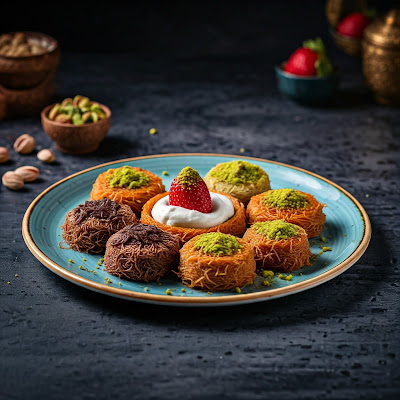What Does Kunafa Taste Like? A Journey Through the
Flavors of a Middle Eastern Delight
Kunafa (also spelled knafeh or
kanafeh) is more than just a dessert—it's a celebration of flavor, texture, and
tradition. As one of the most beloved sweets in Middle Eastern cuisine, Kunafa
is often served during special occasions, religious festivities, and family
gatherings. But what makes this dessert so special? And more importantly, what
does Kunafa taste like?
In this article, we’ll explore the
unique taste and textures of Kunafa, its different variations, and why it
continues to captivate dessert lovers worldwide.
What
is Kunafa?
Kunafa is a traditional Middle
Eastern dessert made with either thin noodle-like pastry (kataifi) or semolina
dough, layered with a filling of sweet cheese, clotted cream, or other
ingredients. It’s baked to perfection and soaked in a fragrant sugar syrup
infused with rose water or orange blossom water.
This dessert comes in various
regional forms, such as:
- Kunafa Nabulsi:
Made with stretchy Nabulsi cheese, originating from Nablus in Palestine.
- Kunafa Khishneh:
Features a crispy, shredded pastry topping.
- Kunafa Na’ameh:
A smoother version made with semolina dough.
The
Flavors of Kunafa
Kunafa offers a complex yet
harmonious taste that makes it truly unique. Let’s break down its flavor
profile:
1.
Sweet and Floral Syrup
The dessert is generously drizzled
with sugar syrup infused with rose water or orange blossom water,
giving it a sweet, floral aroma. This syrup balances the richness of the cheese
or cream filling, adding a delicate yet pronounced sweetness.
2.
Rich Cheese Filling
The cheese used in Kunafa is mild,
slightly salty, and creamy, often a contrast to the sweet syrup. This combination
of sweet and savory flavors is one of Kunafa’s defining characteristics.
Traditional recipes use stretchy cheeses like Nabulsi or Akkawi,
while some variations incorporate cream or mascarpone for a richer taste.
3.
Buttery, Nutty Pastry
The kataifi or semolina dough is
often brushed with butter or ghee before baking, creating a golden, crispy
crust. This buttery richness complements the dessert’s creamy and sweet
components.
4.
Subtle Citrus Notes
If orange blossom water is used,
Kunafa has a slight citrusy tang that elevates its flavor profile, adding
brightness to the richness of the dessert.
What
Makes Kunafa’s Texture Unique?
Kunafa isn’t just about flavor; its
texture is equally captivating.
- Crunchy Crust:
In varieties like Kunafa Khishneh, the shredded kataifi pastry becomes
crisp and golden when baked, adding a delightful crunch.
- Creamy and Gooey Filling: The warm, melted cheese or cream creates a luscious,
velvety texture.
- Moist and Syrupy Layers: The sugar syrup soaks into the layers, ensuring every
bite is moist and flavorful without being overly soggy.
How
Do Different Kunafa Types Taste?
Kunafa
Nabulsi
- Taste:
Savory yet sweet, with a strong cheesy flavor balanced by the syrup’s
floral notes.
- Texture:
Stretchy cheese layered with smooth semolina dough.
Kunafa
Khishneh
- Taste:
Buttery, nutty, and sweet, with a mild cheese or cream filling.
- Texture:
Crispy and crunchy on the outside, with a creamy interior.
Kunafa
Na’ameh
- Taste:
Rich and smooth, with a slightly softer sweetness compared to Khishneh.
- Texture:
Velvety, as it uses fine semolina dough instead of shredded pastry.
Who
Will Enjoy Kunafa?
Kunafa is ideal for:
- Lovers of Rich Desserts: Its buttery, cheesy layers make it a decadent treat.
- Fans of Sweet and Savory Combos: The interplay of salty cheese and sweet syrup is
irresistible.
- Adventurous Foodies:
If you’re eager to explore Middle Eastern cuisine, Kunafa is a must-try.
When
is Kunafa Served?
Kunafa holds a special place in
Middle Eastern culture and is often enjoyed:
- During Ramadan:
It’s a popular dessert to break the fast, thanks to its energy-boosting
ingredients.
- At Celebrations:
Weddings, Eid, and family gatherings frequently feature Kunafa.
- As a Comfort Food:
Its warm, cheesy goodness makes it perfect for any indulgent occasion.
Pairing
Kunafa with Other Flavors
Kunafa pairs wonderfully with:
- Turkish Coffee:
The strong, bitter flavor of coffee balances Kunafa’s sweetness.
- Mint Tea:
A refreshing cup of tea helps cleanse the palate between bites.
- Pistachios:
Many recipes include a sprinkle of crushed pistachios for added nuttiness.
Is
Kunafa Too Sweet?
While Kunafa is undeniably sweet,
the addition of savory cheese or cream prevents it from being overwhelmingly
sugary. The balance of flavors is what makes it universally appealing.
Final
Thoughts: What Does Kunafa Taste Like?
Kunafa is a harmonious blend of
contrasts—crunchy and creamy, sweet and savory, rich and floral. Every bite
delivers a unique combination of flavors and textures that delight the senses.
For those seeking a dessert that
embodies the heart and soul of Middle Eastern cuisine, Kunafa is an
unforgettable experience. Whether you enjoy it during a festive celebration or
as a simple indulgence, one thing is certain: Kunafa leaves a lasting
impression on your taste buds.
So, are you ready to take a bite of
this iconic dessert?
Would you like additional sections,
such as a Kunafa recipe or tips on where to find the best Kunafa?






